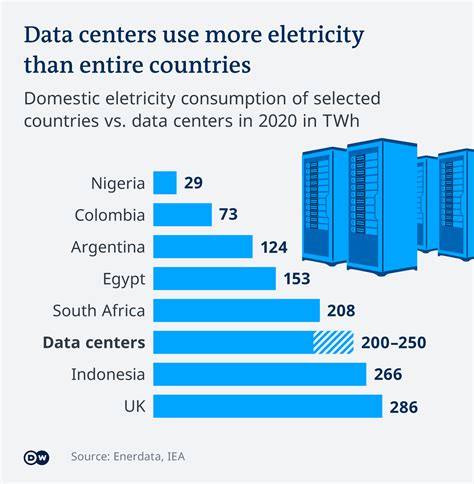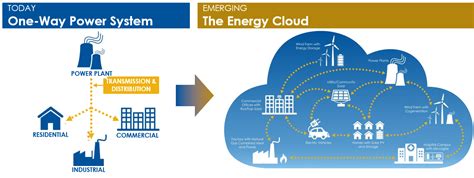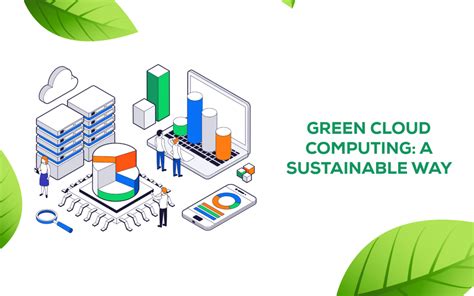Breaking News


Popular News


Explore the environmental impact of cloud computing, including energy consumption, carbon emissions, and efforts to reduce environmental impact. Learn about sustainable practices and renewable energy in cloud infrastructure.In today’s digital age, cloud computing has become an integral part of our everyday lives, enabling us to store and access data and applications from anywhere at any time. However, the environmental impact of this technology is often overlooked. As the demand for cloud services continues to grow, so does the energy consumption of the massive data centers that power them. These data centers not only consume a significant amount of energy but also contribute to carbon emissions, further exacerbating climate change.
In this blog post, we will delve into the environmental implications of cloud computing, from the energy consumption of data centers to the carbon emissions from cloud services. We will also explore the efforts being made to reduce the environmental impact of cloud computing, including the use of renewable energy in cloud infrastructure and sustainable practices that can mitigate the environmental footprint of this technology. Join us as we examine the intricate relationship between cloud computing and the environment, and discover what steps are being taken to create a more sustainable digital future.
Contents

Cloud computing is the delivery of various services through the internet. These services include data storage, servers, databases, networking, software, and more. Instead of owning their own computing infrastructure or data centers, companies can rent access to anything from applications to storage from a cloud service provider. This model has become increasingly popular in recent years due to its flexibility, scalability, and cost-effectiveness.
One of the key benefits of cloud computing is that it allows organizations to access and utilize resources on-demand, which means they only pay for what they need at any given time. This can lead to significant cost savings, especially for smaller businesses that may not have the capital to invest in their own infrastructure. Additionally, cloud computing allows for greater flexibility and agility, as resources can be quickly and easily scaled up or down to meet changing business needs.
Another important aspect of cloud computing is the ability to access data and applications from anywhere with an internet connection. This makes it easier for employees to work remotely, collaborate in real-time, and access the tools and information they need to be productive. By removing the barriers of a traditional office environment, cloud computing can enable greater efficiency and innovation within an organization.
Overall, cloud computing has revolutionized the way businesses and individuals access and utilize computing resources. By leveraging the power of the internet, organizations can streamline their operations, reduce costs, and drive innovation at a pace never before possible.

Energy consumption of data centers is a critical issue that is often overlooked in the discussion of cloud computing. Data centers are massive facilities that house thousands of servers, storage devices, and networking equipment, all of which require a significant amount of power to operate. The energy consumption of these data centers is a major concern due to the environmental impact of high electricity usage.
One of the main contributors to the high energy consumption of data centers is the cooling systems required to maintain the optimal operating temperature for the servers and other hardware. These cooling systems require a substantial amount of electricity to run, which adds to the overall energy consumption of the data center.
In addition to the energy consumption of data centers, there is also the issue of electronic waste produced by the constant turnover of hardware. As technology evolves, older equipment becomes obsolete and must be replaced, leading to the disposal of large amounts of electronic waste. This further contributes to the environmental impact of data centers.
Efforts to reduce the energy consumption of data centers are underway, with initiatives focused on improving the efficiency of cooling systems, optimizing server utilization, and implementing renewable energy sources. By addressing these issues, data centers can work towards reducing their environmental impact and creating a more sustainable infrastructure for cloud computing.

Cloud services have grown to become an integral part of modern technology, offering countless benefits such as cost-effectiveness, scalability, and accessibility. However, the environmental impact of cloud computing is a growing concern, particularly in relation to carbon emissions. The immense energy required to power data centers and infrastructure for cloud services significantly contributes to carbon emissions, ultimately impacting the environment.
According to studies, data centers and cloud services are responsible for a significant portion of global energy consumption and carbon emissions. The continuous operation of servers, cooling systems, and other infrastructure components necessitates a substantial amount of energy, much of which is derived from non-renewable sources. This reliance on non-renewable energy contributes to carbon emissions, further exacerbating environmental concerns.
Efforts to mitigate the carbon emissions from cloud services are essential for promoting environmental sustainability. Companies in the tech industry are increasingly recognizing the importance of adopting renewable energy sources to power their data centers and cloud infrastructure. By prioritizing the use of renewable energy such as wind or solar power, cloud service providers can significantly reduce their carbon emissions and lessen their environmental impact.
In addition to utilizing renewable energy, the implementation of sustainable practices in cloud computing is crucial for minimizing carbon emissions. This includes optimizing server efficiency, improving infrastructure design, and implementing energy-efficient cooling systems. Through these measures, the environmental impact of cloud services can be mitigated, paving the way for a more sustainable and eco-friendly approach to technology.

One of the most pressing issues in the tech industry today is the environmental impact of cloud computing. As more and more data is stored and processed in the cloud, the energy consumption of data centers has skyrocketed, leading to a significant increase in carbon emissions. However, efforts are being made to mitigate these environmental concerns and reduce the overall impact of cloud computing.
One key area of focus for reducing the environmental impact of cloud computing is through the use of renewable energy sources. Many cloud service providers are investing in sustainable infrastructure and are increasingly turning to solar, wind, and hydroelectric power to power their data centers. By utilizing renewable energy, these companies are able to significantly reduce their carbon emissions and lessen their overall environmental impact.
In addition to renewable energy, cloud service providers are also implementing energy efficient technologies and strategies. This includes utilizing advanced cooling systems, optimizing server utilization, and adopting energy efficient hardware. These efforts are not only reducing the energy consumption of data centers but also decreasing the overall carbon footprint of cloud services.
Furthermore, there is a growing trend towards implementing sustainable practices in cloud computing. This includes advocating for responsible data management, minimizing e-waste, and promoting energy efficiency throughout the lifecycle of cloud infrastructure. By incorporating these sustainable practices, the tech industry is taking significant steps to reduce the environmental impact of cloud computing.

One of the key areas that has been receiving attention in the cloud computing industry is the use of renewable energy to power data centers and other infrastructure. The demand for cloud services is continually growing, and as a result, the energy consumption of data centers is also increasing. This has raised concerns about the environmental impact of cloud computing.
In response to these concerns, many cloud service providers have made efforts to shift towards using renewable energy sources to power their infrastructure. This often involves investing in renewable energy projects such as solar and wind farms, and entering into agreements to purchase renewable energy. By using renewable energy, cloud service providers can reduce their carbon footprint and minimize their environmental impact.
Furthermore, some companies have taken it a step further by building their own renewable energy facilities, such as solar arrays and wind turbines, to power their data centers. This not only helps them meet their energy needs sustainably, but also allows them to have greater control over their energy supply and costs.
Overall, the use of renewable energy in cloud infrastructure is a positive step towards creating a more sustainable and environmentally friendly cloud computing industry. As the demand for cloud services continues to grow, it is important for companies to prioritize the use of renewable energy and implement sustainable practices to minimize their environmental impact.

As the demand for cloud computing continues to grow, a pressing concern among many is the environmental impact of this technology. Sustainable practices are vital in ensuring that cloud computing does not further contribute to climate change and environmental degradation.
One way that cloud computing providers can adopt sustainable practices is by investing in renewable energy sources to power their data centers. By using solar, wind, and hydroelectric power, these companies can significantly reduce their carbon footprint and minimize their environmental impact.
In addition, adopting energy-efficient hardware and cooling systems can help reduce the overall energy consumption of data centers. This can be achieved through the use of energy-efficient processors, solid-state drives, and innovative cooling technologies, all of which contribute to a more sustainable approach to cloud computing.
Furthermore, implementing efficient resource utilization and reducing electronic waste through responsible disposal and recycling practices can further promote sustainability in cloud computing. By optimizing server utilization and implementing virtualization technologies, cloud providers can minimize the amount of physical hardware required, thereby reducing their environmental impact.

What is the environmental impact of cloud computing?
Cloud computing has both positive and negative environmental impacts. On the positive side, it can lead to reduced energy consumption and lower carbon emissions by reducing the need for on-site servers. However, the data centers that support cloud computing also consume a significant amount of energy and have a carbon footprint.
How does cloud computing reduce energy consumption?
Cloud computing reduces energy consumption by enabling organizations to use shared resources in large data centers, which are often more energy-efficient than on-site servers. Additionally, cloud providers can optimize their data centers for energy efficiency and renewable energy use.
What are the environmental concerns related to data centers?
Data centers consume a significant amount of energy for cooling, power, and equipment maintenance, which can contribute to carbon emissions. Additionally, the manufacturing and disposal of data center equipment also have environmental impacts.
Can cloud computing be more sustainable?
Yes, cloud computing can be more sustainable through strategies such as using renewable energy sources to power data centers, optimizing energy efficiency, and designing equipment for easier recycling and disposal.
What are the challenges in making cloud computing more environmentally friendly?
Challenges in making cloud computing more environmentally friendly include the high energy consumption of data centers, the reliance on non-renewable energy sources, and the global expansion of cloud infrastructure.
How can businesses reduce the environmental impact of their cloud usage?
Businesses can reduce the environmental impact of their cloud usage by selecting cloud providers with a commitment to sustainability, optimizing their cloud infrastructure for energy efficiency, and setting goals for carbon reduction and renewable energy use.
What are some examples of sustainable cloud computing practices?
Examples of sustainable cloud computing practices include using energy-efficient hardware, employing efficient cooling systems in data centers, and offsetting carbon emissions through renewable energy credits or carbon offset programs.